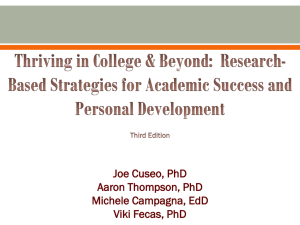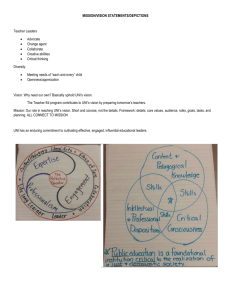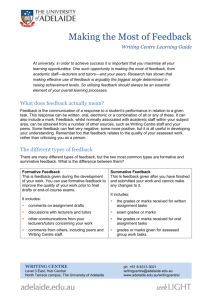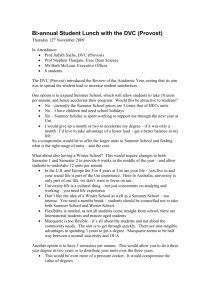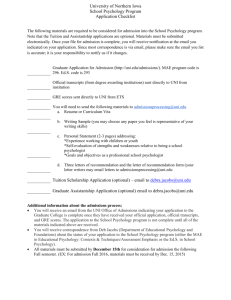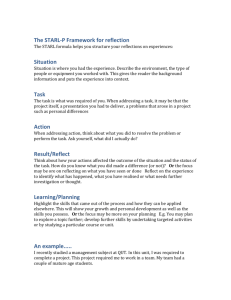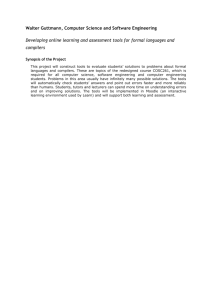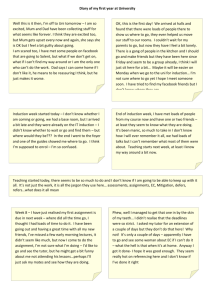With a Little Help From My Friends:
advertisement
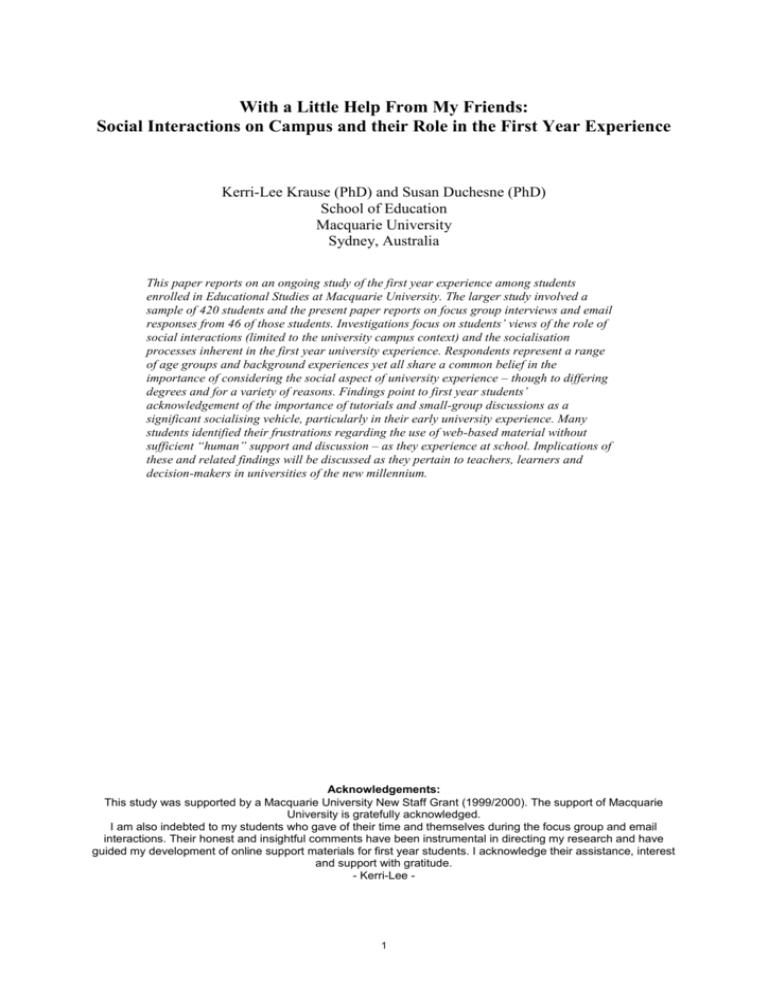
With a Little Help From My Friends: Social Interactions on Campus and their Role in the First Year Experience Kerri-Lee Krause (PhD) and Susan Duchesne (PhD) School of Education Macquarie University Sydney, Australia This paper reports on an ongoing study of the first year experience among students enrolled in Educational Studies at Macquarie University. The larger study involved a sample of 420 students and the present paper reports on focus group interviews and email responses from 46 of those students. Investigations focus on students’ views of the role of social interactions (limited to the university campus context) and the socialisation processes inherent in the first year university experience. Respondents represent a range of age groups and background experiences yet all share a common belief in the importance of considering the social aspect of university experience – though to differing degrees and for a variety of reasons. Findings point to first year students’ acknowledgement of the importance of tutorials and small-group discussions as a significant socialising vehicle, particularly in their early university experience. Many students identified their frustrations regarding the use of web-based material without sufficient “human” support and discussion – as they experience at school. Implications of these and related findings will be discussed as they pertain to teachers, learners and decision-makers in universities of the new millennium. Acknowledgements: This study was supported by a Macquarie University New Staff Grant (1999/2000). The support of Macquarie University is gratefully acknowledged. I am also indebted to my students who gave of their time and themselves during the focus group and email interactions. Their honest and insightful comments have been instrumental in directing my research and have guided my development of online support materials for first year students. I acknowledge their assistance, interest and support with gratitude. - Kerri-Lee - 1 Introduction I once told my mates that it [being at university for the first time] was like being put on Mars and told to act normal and do everything the same as I have before, but of course it’s hard cause you don’t know what to do and where everything is. (first year student respondent) This paper reports on a portion of a larger ongoing study of the first year experience among students enrolled in Educational Studies at Macquarie University. This facet of the study adopts a descriptive exploratory design and addresses the central question of the nature and role of social interactions in the first year of university, with particular focus on the relationship between the social and academic aspects of first year students’ experiences. It arose from the authors’ close contact with students in the unit in question over a number of years, and an associated interest in an holistic approach to the first year experience – encompassing both academic and social support needs. The value of student-student and student-faculty interactions in a range of contexts has been well documented (Kraemer, 1997; Nagda et al., 1998; Pascarella & Terenzini, 1991; Tinto, 1993 Volkwein & Carbone, 1994). The quality and nature of social interactions has been found to have a strong impact on university retention rates (Terenzini & Pascarella, 1977; Pascarella & Terenzini, 1979) and influence on students’ ability to successfully navigate their way through their own academic development (Bruffee, 1993) and sense of competency (Nagda et al., 1998; Tinto, 1993). Research indicates that the contact should involve both student-student and student-faculty interactions and should occur early in the students’ university career since this is the time when students are most likely to depart (Levin & Levin, 1991). Tinto (1993) draws attention to the importance of integrating first year students both socially and academically if they are to benefit most from their university experience. Nora (1993) supports the interdependence of social and academic intergration, defining them respectively as follows: Academic integration: The development of a strong affiliation with the college academic environment both in the classroom and outside of class. Includes interactions with faculty, academic staff, and peers but of an academic nature (e.g., peer tutoring, study groups) (p. 235) Social integration: The development of a strong affiliation with the college social environment both in the classroom and outside of class. Includes interactions with faculty, academic staff, and peers but of a social nature (e.g., peer group interactions, involvement in organizations). (p. 237) Once again, Nora’s work confirms the important link between such integration – early in students’ experiences – and university retention rates. The pivotal role played by peers and social interactions in a range of contexts – and, in particular, the learning context for the purposes of this paper - throughout our lives is well documented. Erikson’s (1963, 1980) seminal theory of psychosocial development points to the way in which the individual’s relationships with others at different stages throughout life mould the personality and influence identity formation. This is particularly important during periods of transition, when one is placed in a new social context, with concomitant demands including physical, emotional and 2 intellectual. The transition to university from school, the workplace or home represents one such challenge. The link between social interaction and the quality of learning is an important one. Vygotsky’s (1978, 1993) sociocultural perspective of learning strongly argues for the interdependence of cognitive development – and the associated impact on learning – and the nature and quality of interactions with people and the tools that culture provides to support thinking. Knowledge, ideas, attitudes and values develop through interaction with others (see also Hartup, 1989; Johnson and Johnson, 1994). Tinto (1998) and others (see for example Bruffee, 1993; Goodsell, Maher, & Tinto, 1992; Kuh & Vesper, 1997) support this notion through research in university settings. Tinto argues that as students spend time learning together, the quality of their learning is enhanced and their knowledge enriched. This social interaction allows students to experience what some refer to as ‘gaining a voice in the construction of knowledge’ (Tinto, 1998, p. 172) – they discover a ‘voice’ of which they may not have previously been aware and through such social learning experiences, students’ learning is ‘validated’ (Rendon, 1994). One significant force changing the nature of social interactions on university campuses – whether real or virtual – is that of information technologies. They are dramatically altering the face of teaching and learning in university contexts and have received much attention in recent years. Pascarella and Terenzini (1998) comment that educators believe that these new technologies offer opportunities to ‘expand access to higher education, to respond to diverse student learning styles, to provide vehicles for active student involvement, and to reduce costs’ (p. 159) – high praise indeed. However, these authors sound a cautionary note, posing substantive questions like ‘do they work?’, and ‘effectiveness at what cost?’. These are important questions in the context of the present study which examines the nature of social interactions among first year university students and the possible links between these relationships and the quality of student learning. There is no doubt that online technology dramatically alters the ways in which we communicate. It is crucial that we survey students’ attitudes to these changes with a view to monitoring their capacity for adaptation to new ways of learning and communicating. While there is some research in this area (see for example Astin, 1993; Pascarella and Terenzini, 1991), there is a need for greater consideration of students’ perceptions of the demands of the technology and its potential impact on their learning and social contact with peers and lecturers/tutors. Method Participants Of the 420 students surveyed as part of the larger study, a total of 46 students responded to the invitation to take part in a follow-up study focussing on the issues of social and academic support needs of first year university students. Of those 46, 32 students participated in focus group discussions (comprising five groups) and 14 students chose to respond to questions and add comments of their own via email. In most cases, participants in the latter category indicated that they were too busy to schedule a time for a lunchtime focus group discussion, but were agreeable to 3 participating in their own time via email. Age and sex distribution of the sample is outlined below. Sex Age group/status Female First year school leaver First year mature age Other First year school leaver First year mature age Other Male Focus groups (n) 10 5 6 5 2 4 Email participants (n) 6 2 1 3 1 1 Students comprising the “other” category were primarily graduate diploma students who had completed an undergraduate degree at another institution and were enrolled in a one year full-time (or two year part-time) teaching diploma course. While it was not their first year at university, these students were enrolled in a first year university course and shared tutorials with first year students. The researchers considered their input a valuable addition to the study. Procedure With approval from the Macquarie University Ethics Committee (human subjects) a series of exploratory questions was designed to elicit responses on the topic of “Socialisation and Friendships at University”. These are listed below. Focus groups extended the range of topics discussed quite considerably, however, those responding via email tended to restrict their comments to the questions listed. Focus groups met for a period of one hour early in the second semester of their first year. The unit in which they were surveyed was offered in their first semester at university. Focus Group Questions: Many students describe uni in the following ways:“it’s such a lonely place” “there are so many people with so many different ideas” “I don’t know anyone” “it’s very different to school” “it’s quite alienating and hard to make friends with people” Was any of this true for you, or for people you know? Why? 2. Do you think it’s important to examine the social aspects of uni? Why? 3. One student told me: “it took me a long time to adjust to uni life!”. Was this true for you? In what ways? What can/should be done to try to help students to “adjust”? 4. What advice would you give a first year uni student in terms of forming friendship and/or support groups? 5. Have your friends/contacts at uni made any difference to your attitude to the university? your decision to stay at uni? your attitudes to your work? How??? 6. Knowing what you know now (in Semester 2) about the way university works, what kinds of things do you wish you had known when you first started uni? Verbal and written responses were content analysed, using printed email responses and transcriptions of focus group interactions. This process required direct interaction between the two analysts – one of which conducted the focus group discussions – 4 and the written data. Initially, line by line coding was manually undertaken, for instance, this involved reading, browsing, validation of codes and searching for emerging patterns in the data. The two analysts met to validate codings and derive statements of hypothetical relationships or hypotheses from the data. These hypotheses were either confirmed, modified or discarded on the basis of further discussion, conceptualisation, and empirical evidence from the data. In this way, we sought to establish intercoder reliability, consensus, and verification of emerging themes. Findings and Discussion This section reports on three key themes and a number of subthemes emerging from student responses. The first theme outlines the “why?” of social interaction at university and presents students’ reasons for identifying social interactions as integral to their university experiences and attitudes to study and the university as a whole. The second theme encompasses the “when and where?” of social interactions at university. Students identified several university-related contexts in which socialising plays an important role and these are summarised in the words of participants. The final theme addresses the “how?” question. How is social interaction best facilitated? Whose responsibility is it? And what role, if any, do students believe academics should play in facilitating the socialisation process more effectively? Theme 1: Why? The first theme comprises four subthemes and includes a number of views as to the importance of social interactions during the early part of students’ university experience. Evidence indicates that participants’ views differ depending on such variables as age, personality, proximity of students’ home to the campus – some students are able to go home at lunchtime and may spend only an hour at a time on the campus, number of school friends attending the same campus and previous experience in the workforce. Subtheme 1.1. Social interactions are central to university life The majority of participants identified the social aspects of university as integral to university life: it is important to explore the social aspects of uni, as it is often the social aspects of uni which determine how a person feels about attending uni . . . someone may despise the social atmosphere/aspects of their uni and not go because they feel uncomfortable and it is an aspect involved in every activity of uni, both academic and sporting. A similar comment was made by a first year school-leaver who provided an honest appraisal of the interrelationships between social, affective and academic factors in the first year experience: I have a friend, she is really intelligent and she finds it so hard to make friends and she’s really depressed and it’s just affecting her whole life. And I know I’m the same – if I don’t have relationships with people it sobers me right down and you have these negative connotations for the whole of uni – it’s like I’m 5 going to go there and I’m going to feel so alone and I’ll be walking up to the cafeteria and hoping I may meet someone I know . . . You go to the class and then you leave the class . . . and unless you hang around and make the effort, it’s very depressing. Subtheme 1.2. Social interactions perform different functions Respondents distinguished between social interactions pertaining to their academic pursuits – such as in tutorial groups - and those interactions relating to leisure pursuits, such as sport or other interests. During these interviews, students devoted most discussion time to the role of peers and acquaintances in supporting and assisting them with academic-related matters. This may be attributed to the fact that the interviewer was also one of their lecturers. Nevertheless, students clearly distinguished between academic and leisure-related social roles and attached most importance to the former. 1.2a. leisure-related interactions Comments on the role of university sporting and social clubs were in the minority. Most students admitted that they preferred to spend leisure time away from university and did not typically spend such time socialising with ‘university friends’. One mature age first year respondent commented on the importance of social and sporting clubs in helping him to adjust and make friends at university: I’m involved in the [club name given] here and that’s been really handy . . . You see someone that you know and you can sit next to them and I’ve got to know some people that way. Not on the academic side of things . . . Just knowing people and familiar faces makes the experience a bit more comfortable. No students in the sample were involved in university-related sporting teams or clubs and a small number were active members of specific-interest university associations or societies. Those who were involved socially in this way commented on the important role that friends in such associations played: I think that [belonging to – university association named] was what changed my opinion of uni. I went on a camp mid-year for a week and I saw so many friends and it changed from being a ‘hi-bye’ relationship to really knowing people who make you feel like you belong and make you comfortable. It’s made such a difference. One reason for the apparently limited nature of these students’ integration into university life may be that all but one of them lived off campus. In American-based college research, it seems that colleges and universities with on-campus residential arrangements achieve a very different social environment and the level of social integration is thus much higher. The time factor was one of the major reasons given by students in the present study for limited involvement in social interactions: I think social groups can be good in getting to know people if you have the time. . . but once again it’s the time factor. You just don’t have the time to get involved. 6 1.2b. interactions on and off campus A further distinction was made between ‘university friends’ and ‘friends outside uni’. On the whole, participants clearly distinguished between social interactions at university as opposed to those outside of university. Differences between responses were typically evident on the basis of age and university experience, though there were some exceptions. Without exception, mature age students (both first year and graduate) in the sample distinguished between their network of ‘friends’ off campus and ‘associates’ on campus, directly related to their work. Only one of the mature age students belonged to a social club on campus. All agreed that social interaction was valuable and important particularly for their academic progress. One mature age first year student summarised this view – also expressed by his mature age peers in the sample - saying: You meet the person sitting next to you in the tut, and a couple of others in your course, and those contacts are great for study partners, but I don’t really have much contact with them outside of uni . . . I don’t want a whole group of friends at uni to distract me from my study. The views of first year school-leavers in this respect tended to be split. Some were obviously loners and did not depend on collaboration or sharing of ideas with peers on campus. One student admitted very honestly: I’m not really close to anyone . . . Why are you going to develop relationships? Is it really for the subject matter that you are doing? It’s an awful motive sort of thing. It’s a user relationship rather than – this is a person I really care about. It’s what this person can do for you type of relationship and when you leave uni then the relationship ends. Another agreed, saying: Sometimes I think it would be nice to talk to someone about a subject or about work I’m having trouble with, but other than that I don’t really [feel the need to talk to anyone at uni]. It’s not an issue really. However, such views were not commonly shared by the majority of students who attached importance to their ‘university friends’, while admitting that they rarely socialised with them off campus: Of course I made new friends in tuts and lectures, but they were more associates, I did not see them outside of uni and did not socialise with them in any way. 7 Subtheme 1.3. Social interaction and the link to student satisfaction levels Responses pertaining to this sub-theme illustrate the potential link between peers, student satisfaction levels and university retention rates. Peers may play a role in students’ decisions to stay or go within the first three weeks of university, according to one student who made this link very clearly: If you know someone in lectures and you miss a lecture then you know you will be able to catch up. Whereas if you don’t know somebody there and you miss a few lectures here and there, then you feel behind and if it’s early in the piece you might drop the subject because you think – “well I can’t catch up now, I don’t know anybody that I can get notes from”. Another student concurred, referring to a friend who ‘only lasted the first year. He came here and met the lecturer, then had no contact at all. It makes such a difference’. Many school-leavers identified the role of one or more of their school friends who had come to the university and had been a support for them: I found it hard to make new friends here. I think at school everyone is the same age and then when you get to uni there are mixed ages and its hard to accept. I tended to still hang out with my friends from school at lunchtimes and between classes. Responses reveal that friends and social interactions play an important role in developing a sense of camaraderie, a sense of belonging and a motivation for staying at the university: I knew no one in three out of my four courses . . . although I knew everyone was in the “same boat”, it did feel like everyone else knew people and I was noticeably the odd one out. When I started to get to know people in my courses – just to say hi – it made such a difference. I didn’t feel like dropping out anymore. and My friends have given me motivation to actually come to uni. It is just the whole atmosphere of just seeing them and talking to them which makes it worthwhile. It encourages me to do well in my subjects. We don’t compete against each other but we do share our work and it does feel good. (first year student respondent) Subtheme 1.4. Social interactions and academic work Respondents spent considerable time discussing the role of social interactions in assisting them academically at university. Tinto (1998) argues that academic integration seems to be the more important form of involvement and the prevalence of this type of interaction was supported by the present study. Opportunities for social contact and discussions with other students were seen as important to make up for difficulties in contacting lecturers and tutors. One first year student commented: You can ask you tutor but often they can be – the answer you get from them isn’t very clear. Because they are looking at the subject from their perspective 8 . . . they know everything there is to know about it and so their answer is very different from somebody else who is doing the subject. Some of these difficulties arise from an admitted apprehension about approaching lecturers or tutors: Maybe there are things I want to speak to someone about but I don’t feel confident enough to speak to my tutor about it. Another participant contrasted the university environment with that of school, which was associated with the support of friends and the accessibility of teachers: All of a sudden you find it’s not explained to you and you don’t have the support of your friends around you to ask the little questions . . . You can’t just go off to the teacher and ask a question. You may not even know where your lecturer is and then it’s like – Oh, I’ve got to try to find out where they are and where’s the building and . . . you feel so overwhelmed and you feel you can’t cope. In their own right, peers were perceived as being able to make suggestions that were more accessible to students than the help lecturers provided: I find my friends give me more practical help because they are they ones doing the research and finding stuff and trying to formulate ideas. Yes, I find them more helpful. And Maybe if I find a good article or something like that I’ll pass it on to that person. You sort of hope that sometime down the line they might reciprocate. Commenting on the importance of peer collaboration and encouragement in assignment preparation, one first year student said: I would run around and ask my friends to read this and tell me if it was OK. It gives you a bit of confidence. And also you can read theirs as well then you can say – oh this is really good. Have I done that right? Another said: Socially here I think it’s important to have friends to discuss things with. and I don’t know how people survive as lone rangers at uni . . . I guess I find it very helpful to be just chatting to others in the group about what we are learning. We push each other along to learn from each other and I found that quite useful. Students expressed a clear view that opportunities to discuss assignments with peers were an important part of the assignment preparation process. Being able to share common problems and ‘talk it out’ was a common concern for many respondents: I just find talking to others you find someone who usually has the same problem and then you sit down and work through the problem. It usually saves time . . . so it is better to talk about the problems one has in common. and 9 We need our peers to check that we are on the right track and doing the right thing – to check with each other. It just gives you confidence to know that you are on the right track. This view is supported by the Vygotskian principle of peer tutoring (Woolfolk, 1998) which argues that peers are sometimes more likely than teachers to provide assistance at the appropriate level. Courses in which face to face interaction with tutors and peers was not possible, or simply did not occur were perceived as more difficult than others in which students did have contact with their peers, in particular: You had no support. I really did not know anyone that was doing the course and there were no tuts or anything. You didn’t have people around that you could talk to. Thus for example, students identified courses taken externally or in distance mode as much more difficult, and attributed this to the lack of contact with other students taking the course: I did [course named] in first semester and one of the difficulties with doing the subject externally is with tutorials – until you get to the residential schools you don’t have a chance to discuss anything – you are on your own. I found that so difficult. These concerns have implications for the provision of distance education and the forms of communication – with peers, academic staff, and support staff - facilitated by such delivery modes. The use of online communication is discussed further in Theme 3 below. In summary, the responses in Theme 1 illustrate students’ primary concern with what Nora (1993) terms academic integration, as opposed to social integration. Students in this sample make a clear distinction between their social lives at university and their off-campus life. This does not always appear to be the case in much of the American-based research surveyed, where full integration – both socially and academically is encouraged, since so many students live on or near the campus. It is important to recognise these differences in the nature of university life in many Australian universities – particularly those in large cities, as opposed to those in regional centres where most students may reside on campus – and to identify ways in which approaches to social integration may need to be adapted to meet the diversity of student needs. Theme 2: When and Where? Respondents identified a number of contexts in which social interactions took place. These are presented below, along with student explanations as to their relative importance. Subtheme 2.1. The lecture theatre Lectures tended not to be a place where substantial contacts were made, yet students admitted their discomfort in the early weeks of semester when they had no 10 one to talk to or to sit with in lectures. Some students avoided talking to others they did not know during lectures. Others said that while they might say ‘hello’ to people, the contact would mostly end there, particularly in the early weeks of the semester: For the first years it’s like ‘don’t sit next to anyone else’ – leave two spaces on either side. and If you don’t sit next to people you don’t talk to them. It is quite intimate when you are sitting next to someone in those lecture theatres. It’s a bit threatening to your personal space. A few students commented that it made a big difference ‘if you have a whole group of friends all in one row and you sit next to them and start talking’, but these situations tended to be in the minority. Subtheme 2.2. Small and large group interactions Students widely commented that they had more contact with peers, got to know them better, and were more likely to share ideas in small rather than large groups. I think large tutorial sizes affect how people get to know each other. You know . . . when you are not particularly outgoing you might not speak to a lot of people. Whereas if it were ten people, you might get to know each other better. It is not surprising to find that typically, students’ preference was for smaller tutorial groups: In courses where we had to do group work, in courses where the classes are small -that makes it a lot easier. However, while smaller tutorials were those where students perceived social interaction occurred most easily, there were clearly some larger units in which such profitable interaction took place, according to some participants. Students attributed this to the careful organisation of tutorial or workshop groups, and large tutorials split into smaller groups for discussion, placing a large onus of responsibility on the skill of the tutor: The way they [tutors] do the tuts has a big effect . . . because we normally have a big tut and it’s just a one-on-one discussion with the tutor . . . it’s usually the same people saying things. But one day the tutor wasn’t there and we joined with another big tut group. But we divided into small groups and the discussion was excellent. It made all the difference. The role of the tutor will be expanded upon in the next subtheme. Contacts made in these smaller group situations were identified by several respondents as enduring, extending across other courses shared by the students. Similarly, a few students commented that through group assignments they developed friendships that provided opportunities for discussing other assignments. In the current climate with increasing class sizes, it is important to note that students acknowledged that even in large tutorial classes, as long as the tutor was able to coordinate small group work, the class could be conducted effectively and social interaction successfully facilitated. 11 Subtheme 2.3. Miscellaneous locations and serendipitous experiences In addition to the academic contexts for social interaction, which tended to dominate students’ comments, there were several other occasions on which they were able to socialise. While these did not receive repeated mentions, they are nevertheless worthy of acknowledgement in order to paint the broader picture of student socialisation and socialising at university. Being able to mix socially during periods such as lunchtime was equally as important as being able to associate with peers in classes for some first year school leavers: I was lucky enough to have people from high school to sit with at lunch. A few participants commented on how threatening they found situations between lectures and tutorials when there was a gap of a few hours and no one with whom to spend that time. A number of students identified experiences of common adversity (such as enrolment, or difficulty finding the correct room for a tutorial in the first week) as starting points for friendships with an entry point for sharing other questions or difficulties relating to study later in a unit. In response to the question of how you first meet people, one student commented: Mostly by accident – like turning up to the wrong room and finding out they are doing the same course and they have done the same thing and made the same mistake so you sit next to them. A few others referred to the social interactions facilitated by the ‘trials’ of enrolment day: We started at the enrolment day and for seven hours we walked around . . . and with seven hours of that you become very good friends! Opportunities provided by Orientation Week, clubs and societies were also mentioned by a few students. Theme 3: How? This theme is closely linked to Theme 2, but has been identified specifically because many students in the sample provided useful ‘advice’ and suggestions as to how social interaction may be facilitated on campus – particularly applicable to those involved in coordinating first year units and organising first year orientation programs. While responses on this topic were not extensive and suggestions may not be readily implemented, the honesty of students’ responses nevertheless provides fruitful data for further investigations on the topic – with both students and staff. Subtheme 3.1. Orientation week and associated activities The mature age students in the sample agreed that they would have liked to have seen more activities directed at them - rather than predominantly at first year students – during the Orientation Week. A related concern was the addressing of letters to parents, inviting them to a Family Orientation Evening. This problem has 12 been rectified, but remains an important issue when one considers the increasing numbers of mature age students entering university for the first time. Subtheme 3.2. The role of lecturers and tutors Participants made several comments about the role of lecturers and tutors in facilitating social interaction among first years in a range of ways. While they agreed that academic staff were not ‘responsible for students’ socialisation’ and that these staff had many responsibilities, they made a number of remarks about how social interaction could be accommodated and facilitated. For example, some commented on the significant role lecturers and tutors play in promoting discussion from the beginning of semester, emphasising the importance of providing opportunities for small group discussion in tutorials: Even simple things like getting everyone in the tutorial to introduce themselves to each other and giving them the opportunity to get to know each other. The physical layout of the room was also identified as an important factor in facilitating communication and social contact. One student commented that where desks all faced the front, students tended not to interact or even to make eye contact. A number of students shared this view, emphasising the importance of ‘setting up a friendly, free atmosphere for students to discuss the subject matter’. A safe social environment was highly prized by first year students in particular. Some students’ fears are clearly summarised in the following comment: By doing that [talking in tutorials] you put yourself out there and that’s not something you do in high school. In high school you had support but at uni you don’t know if there’s anyone who thinks the same way as you do. Units in which lecturers knew and used students’ names and promoted interaction were perceived as friendlier than others: I have two tutors who have not bothered to find out our names and I find that really annoying . . . They have no idea who we really are. A similar comment was: I had a tutor like that last semester and we got to week 13 and she was still going ‘You’ – pointing to us - as if they can’t be bothered with you. One mature age student admitted to taking the initiative of organising or actively seeking such contacts when they’re not otherwise available. However, such proactive behaviour does not appear to be the norm. The importance of tutorials for providing face-to-face small group interaction cannot be underestimated: I just sat my [subject named] paper and hated. There was no help. There were no tuts at all and that was just horrible. You didn’t have people around you that you could talk to. Similarly, the value of personal contact with tutors and lecturers was a commonly mentioned issue, as illustrated in the following three comments: 13 And because there are not huge enrolments in the [faculty named] the teachers have a lot of time and they know you and speak to you as you pass in the corridor. I think lecturers and tutors have a responsibility to try to identify students who are having social interaction problems. I understand it’s difficult . . . but . . . they can at least adopt an approachable attitude. When I got to Uni it was such a shock in big subjects where you [the interviewer] lecture and I felt really alone. You had no idea who I was and there wasn’t a personal relationship – I found that a really big shock. Being able to contact and interact with academic staff emerged as a critical theme in this study. While this is not surprising, it does highlight the importance of giving thoughtful consideration to how increased emphasis on online teaching and staffing pressures may influence students’ perceptions (and the reality) of staff accessibility and availability. Several technological innovations are currently in use in the area of distance education and online communications between staff and students and among students, via electronic bulletin boards and the like. The utility of these technologies will require further attention if we are to foster and maintain meaningful, supportive contact, particularly with first year students who sometimes find the electronic environment alienating. Student feedback on such issues is presented in the following subtheme. Subtheme 3.3. Social interactions online Student views on the efficacy and success of online interactions were mixed. Some appreciated being able to use email, particularly if it meant avoiding face-to-face contact with lecturers who seemed a little threatening: Email is always good. Emailing a lecturer or tutor because you don’t like them – that helps. Sometimes – it depends – some tutors are really approachable people and others aren’t If they are approachable then OK, but if not, then email is really good. A few students particularly appreciated electronic bulletin boards because they facilitated increased involvement: The thing about the bulletin board – the quieter people who have very good ideas and don’t get a chance to speak in tuts – they may put their ideas on the bulletin board. That’s good. However, it appeared that provision of opportunities for online contact through bulletin boards did not make up for lack of face to face or telephone contact with peers: I need to do checks. Once I get the assignment topic I go through it and I may discuss it with somebody else and if I’m not satisfied I go to the lecturer. You just can’t do that when it’s all online. This finding forms a partial response to some of the confronting questions posed by Pascarella and Terenzini (1998) who support the central link between student learning and student-faculty and student-student interactions ‘both inside and outside 14 the formal classroom’ (p. 161). They question the impact of technology-facilitated distance education on the ‘frequency, nature and dynamics’ (p. 161) of social interactions, arguing that the educational effects and consequences of cyberspatial distances on the quality of student learning has not yet been adequately explored. The role and nature of online social interactions and tutorial assistance forms part of the focus in the next phase of the study Reflections: What are the implications? The themes outlined above point to the rich source of information supplied by students who willingly shared their views on both social and academic support needs of first year students. A future paper will present data on the latter and research on both issues is ongoing. An important message emanating from students’ responses is that the adjustment period at university is just that – an adjustment and a transition. Some students were very honest about their difficulties during this time: ‘I’m very happy now, but was absolutely miserable for the first couple of months and really felt that NO-ONE understood’ and ‘I did have a hard time before the adjustment – it took me a semester to adjust’. Yet, the consensus within this group of students seemed to be that once the transition period is over, students settle down and tend to have fewer difficulties overall. There is much in this data to encourage those interested in the first year experience. Students understand that large groups are sometimes inevitable but their message to lecturers and tutors is clear: you do make a difference. Whether it involves knowing names, arranging desks and chairs, acknowledging students in university corridors, or managing small group work – all these facets of the learning experience influence students’ social interactions and often make a difference to their attitudes to the unit and possibly the university as a whole. Students value face-to-face interaction and many feel alienated by distance education units. There is an acknowledged inevitability about using new technologies to increase flexibility and efficacy of course delivery. Some students appreciate the technology and embrace it willingly; however, those making strategic decisions about such matters must take into consideration the often overlooked issue of social interaction to ensure that all students are appropriately informed, included and involved. It is interesting to note that many students admit to using the technology to surf the net or write their essays, but when their progress in and grades for a course depend on their computer skills and the quality of their online interactions, and when the human link is missing, students admit to feeling apprehensive and alone in their study. Despite lecturers’ contact details being provided in course materials, students believe that nothing makes up for meeting with other students face to face, hearing their questions and having their common concerns confirmed and then addressed. Electronic bulletin boards go some way towards addressing this problem, but it seems that the balanced approach to technology use is, as always, preferable: the technology is a tool, a vehicle. How we use it and direct it is up to us. The students’ message seems clear: by all means use the technology, but please give us human contact and please give it early in the unit. In their article “Studying college students in the 21st century”, Pascarella and Terenzini (1998) point to the issue of dramatically increasing student diversity as 15 having potentially profound implications for future research in the area of tertiary education. In particular, the authors draw attention to the importance of conducting studies of ‘conditional (or interaction) effects’ (p. 152) to determine how any particular experience differs in magnitude and nature for different kinds of students. In the present small-scale study - with its combination of school-leavers and mature-age students, first year and graduate students returning to complete a diploma and having to share tutorials and lectures with school leavers - the findings confirm the concerns of Pascarella and Terenzini. Conditional effects such as age, previous workforce experience, number of school friends on the campus – to name a few – do seem to influence attitudes towards and the nature of students’ social interactions. Establishing causal links is not at issue here. What is important is the nature of the interaction effects and possible subsequent influences on students’ academic progress and/or achievement, level of satisfaction and decision to stay at university. We were impressed by students’ honesty and the diverse views they expressed on a range of topics. Consulting students and listening to their views should be integral to the ongoing research and decision-making processes of any university and we look forward to extending this study in two ways. First, we plan to track a smaller group taken from the present sample of students through to their third/fourth year of university study. This longitudinal study will continue to investigate the nature of students’ social interactions as they progress through university. It will also focus on the academic question of how students prepare for and undertake written assignments and essays. Possible links between students’ social interactions and attitudes to their study and the university will be explored in an effort to learn more about how we might equip students to meet the social and academic demands of university life from the beginning. Despite this year being one of the hardest in my life, it’s been bearable because I have friends who I study with. We . . . share readings, and I even look forward to seeing them in the workshops. (first year student respondent) 16 Reference List Astin, A. (1993). What matters in college? Four critical years revisited. San Francisco: Jossey-Bass. Bruffee, K. (1993). Collaborative learning: Higher education, interdependence, and the authority of knowledge. Baltimore: Johns Hopkins University Press. Erikson, E. (1963). Childhood and society (2nd ed.). New York: Norton. Erikson, E. (1980). Identity and the life cycle (2nd ed.). New York: Norton. Goodsell, A., Maher, M., & Tinto, V. (Eds.). (1992). Collaborative learning: A sourcebook for higher education. University Park: National Center on Postsecondary Teaching, Learning and Assessment, Pennsylvania State University. Hartup, W. (1989). Social relationships and their developmental significance. American Psychologist, 44, 120-126. Johnson, D., & Johnson, R. (1994). Learning together and alone: Cooperation, competition, and individualization (4th ed.). Boston: Allyn & Bacon. Kraemer, B. (1997). The academic and social integration of hispanic students into college. The Review of Higher Education, 20(2), 163-179. Kuh, G., & Vesper, N. (1997). A comparison of student experiences with good practices in undergraduate education between 1990 and 1994. The Review of Higher Education, 21(1), 43-61. Levin, M., & Levin, J. (1991). A critical examination of academic retention programs for at-risk minority college students. Journal of College Student Development, 32(4), 323-334. Nagda, B. A., Gregerman, S., Jonides, J., von Hippel, W., & Lerner, J. (1998). Undergraduate student-faculty research partnerships affect student retention. The Review of Higher Education, 22(1), 55-72. Nora, A. (1993). Two-year colleges and minority students’ educational aspirations: Help or hindrance? Higher education: Handbook of theory and research (vol. 9), 212-247. Pascarella, E., & Terenzini, P. (1979). Interactive influences in Spady and Tinto’s conceptual models of college attrition. Sociology of Education, 52, 197-210. Pascarella, E., & Terenzini, P. (1991). How college affects students: Findings and insights from twenty years of research. San Francisco: Jossey-Bass. Pascarella, E., & Terenzini, P. (1998). Studying college students in the 21 st century: Meeting new challenges. The Review of Higher Education, 21(2), 151-165. Rendon, L. (1994). Validating culturally diverse students: Toward a new model of learning and student development. Innovative Higher Education, 9(1), 33-52. Terenzini, P., & Pascarella, E. (1977). Voluntary freshman attrition and patterns of social and academic integration in a university: A test of a conceptual model. Research in Higher Education, 6(1), 109-127. Tinto, V. (1993). Leaving college: Rethinking causes and cures of student attrition (2nd ed.). Chicago: University of Chicago Press. Tinto, V. (1998). Colleges as communities: Taking research on student persistence seriously. The Review of Higher Education, 21(2), 167-177. Volkwein, J., & Carbone, D. (1994). The impact of departmental research and teaching climates on undergraduate growth and satisfaction. Journal of Higher Education, 65(2), 146-167. Vygotsky, L. (1978). Mind in society: The development of higher mental processes. Cambridge, MA: Harvard University Press. 17 Vygotsky, L. (1993). The collected works of L. S. Vygotsky: Vol. 2 (J. Knox & C. Stevens, Trans.). New York: Plenum. Woolfolk, A. (1998). Educational psychology (7th ed.). Boston: Allyn & Bacon. 18
